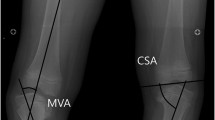Abstract
Purpose
Recurrent genu valgum deformity complicates treatment of congenital femoral deficiencies (CFD) and fibular hemimelia (FH). We analysed factors influencing recurrence.
Methods
Patients who underwent limb lengthening or deformity correction for CFD and/or FH were reviewed. Radiographs after surgery and after a minimum of a further six months were analysed. Change in parameters of mechanical axis deviation per month (∆ MAD/month) and of angle per month were calculated. These parameters were tested against cofactors patient age, baseline MAD, type of CFD and FH, severity of ball-and-socket joints, ankle-joint stiffness, absence of cruciate ligaments and resection of the fibular anlage.
Results
Recurrent valgus deformity was found in 23 of the 42 limbs included with a mean change of MAD of 23.4 mm (5–60 mm). There was no significant difference between patients with ∆ MAD/month <0.5 mm versus >1 mm regarding MAD in the first radiograph and patient age. CFD cases Pappas types VII and VIII showed a ∆ MAD/month of 1.6 mm, whereas milder cases of Pappas IX showed a ∆ MAD/month of 0.8. Mild FH (type Ia) showed a mean ∆ MAD/month of 0.39 mm, whereas mean ∆ MAD/month for FH type Ib/II was 0.72 mm. In FH type II cases, mean ∆ MAD/month was 0.79 mm after resection of the fibular anlage compared with 1.98 mm in those without resection.
Conclusions
Recurrence in FH and CFD was not dependent on patient age but partly on FH and CFD type. Limbs with more severe ball-and-socket knee joints showed more recurrence. Overcorrection depending deformity type should be performed.


Similar content being viewed by others
References
Rogala EJ, Wynne-Davies R, Littlejohn A, Gormley J (1974) Congenital limb anomalies: frequency and aetiological factors. Data from the Edinburgh register of the newborn (1964–8). J Med Genet 11:221–233
Pappas AM (1983) Congenital abnormalities of the femur and related lower extremity malformations: classification and treatment. J Pediatr Orthop 3(1):45–60
Paley D, Standard SC (2007) Lengthening Reconstruction Surgery for Congenital Femoral Deficiency. In: Rozbruch RS, Ilizarov S (eds) Limb lengthening and reconstruction surgery. Informa Healthcare USA, New York, pp 393–412
Achterman C, Kalamchi A (1979) Congenital deficiency of the fibula. J Bone Joint Surg Br 61:133–137
Pappas AM, Hanawalt BJ, Anderson M (1972) Congenital defects of the fibula. Orthop Clin North Am 3:187–199
Manner HM, Radler C, Ganger R, Grill F (2006) Knee deformity in congenital longitudinal deficiencies of the lower extremity. Clin Orthop Relat Res 448:185–192
Baek GH, Kim JK, Chung MS, Lee SK (2008) Terminal hemimelia of the lower extremity: absent lateral ray and a normal fibula. Int Orthop 32(2):263–267
Alman BA, Krajbich JI, Hubbard S (1995) Proximal femoral focal deficiency: results of rotationplasty and Syme amputation. J Bone Joint Surg Am 77(12):1876–1882
Birch JG, Walsh SJ, Small JM, Morton A, Koch KD, Smith C, Cummings D, Buchanan R (1999) Syme amputation for the treatment of fibular deficiency. An evaluation of long-term physical and psychological functional status. J Bone Joint Surg Am 81(11):1511–1518
Fulp T, Davids JR, Meyer LC, Blackhurst DW (1996) Longitudinal deficiency of the fibula: operative treatment. J Bone Joint Surg Am 78:674–682
Patel M, Paley D, Herzenberg JE (2002) Limb-lengthening versus amputation for fibular hemimelia. J Bone Joint Surg Am 84(2):317–319
Stanitski D (2007) Fibular hemimelia. In: Rozbruch RS, Ilizarov S (eds) Limb lengthening and reconstruction surgery. Informa Healthcare USA, New York, pp 449–459
Miller LS, Bell DF (1992) Management of congenital fibular deficiency by Ilizarov technique. J Pediatr Orthop 12:651–657
Catagni MA, Bolano L, Cattaneo R (1991) Management of fibular hemimelia using the Ilizarov method. Orthop Clin North Am 22(4):715–722
Catagni MA, Radwan M, Lovisetti L, Guerreschi F, Elmoghazy NA (2011) Limb Lengthening and Deformity Correction by the Ilizarov Technique in Type III Fibular Hemimelia: An Alternative to Amputation. Clin Orthop Relat Res 469(4):1175–1180
Cheng JC, Chueng KW, Ng BK (1998) Severe progressive deformities after limb lengthening in type-II fibular hemimelia. J Bone Joint Surg Br 80:772–776
Boakes JL, Stevens PM, Moseley RF (1991) Treatment of genu valgus deformity in congenital absence of the fibula. J Pediatr Orthop 11(6):721–724
Stevens PM, Arms D (2000) Postaxial hypoplasia of the lower extremity. J Pediatr Orthop 20(2):166–172
Letts M, Vincent N (1993) Congenital longitudinal deficiency of the fibula (fibular hemimelia). Parental refusal of amputation. Clin Orthop Relat Res 287:160–166
Manner HM, Radler C, Ganger R, Grill F (2006) Dysplasia of the cruciate ligaments: radiographic assessment and classification. J Bone Joint Surg Am 88(1):130–137
Paley D, Tetsworth K (1992) Mechanical axis deviation of the lower limbs: preoperative planning of uniapical angular deformities of the tibia or femur. Clin Orthop Relat Res 280:48–64
Paley D, Tetsworth K (1992) Mechanical axis deviation of the lower limbs: preoperative planning of multiapical frontal plane angular and bowing deformities of the femur and tibia. Clin Orthop Relat Res 280:65–71
Paley D (2003) Radiographic assessment of lower limb deformities. In: Paley D (ed) Principles of deformity correction. Springer, Berlin Heidelber, pp 31–40
Feldman DS, Henderson ER, Levine HB, Schrank PL, Koval KJ, Patel RJ, Spencer DB, Sala DA, Egol KA (2007) Interobserver and intraobserver reliability in lower-limb deformity correction measurements. J Pediatr Orthop 27:204–208
Conflict of Interest
The authors declare that they have no conflict of interest.
Author information
Authors and Affiliations
Corresponding author
Additional information
Investigation performed at the Orthopaedic Hospital Speising, Vienna, Austria
Rights and permissions
About this article
Cite this article
Radler, C., Antonietti, G., Ganger, R. et al. Recurrence of axial malalignment after surgical correction in congenital femoral deficiency and fibular hemimelia. International Orthopaedics (SICOT) 35, 1683–1688 (2011). https://doi.org/10.1007/s00264-011-1266-y
Received:
Revised:
Accepted:
Published:
Issue Date:
DOI: https://doi.org/10.1007/s00264-011-1266-y




